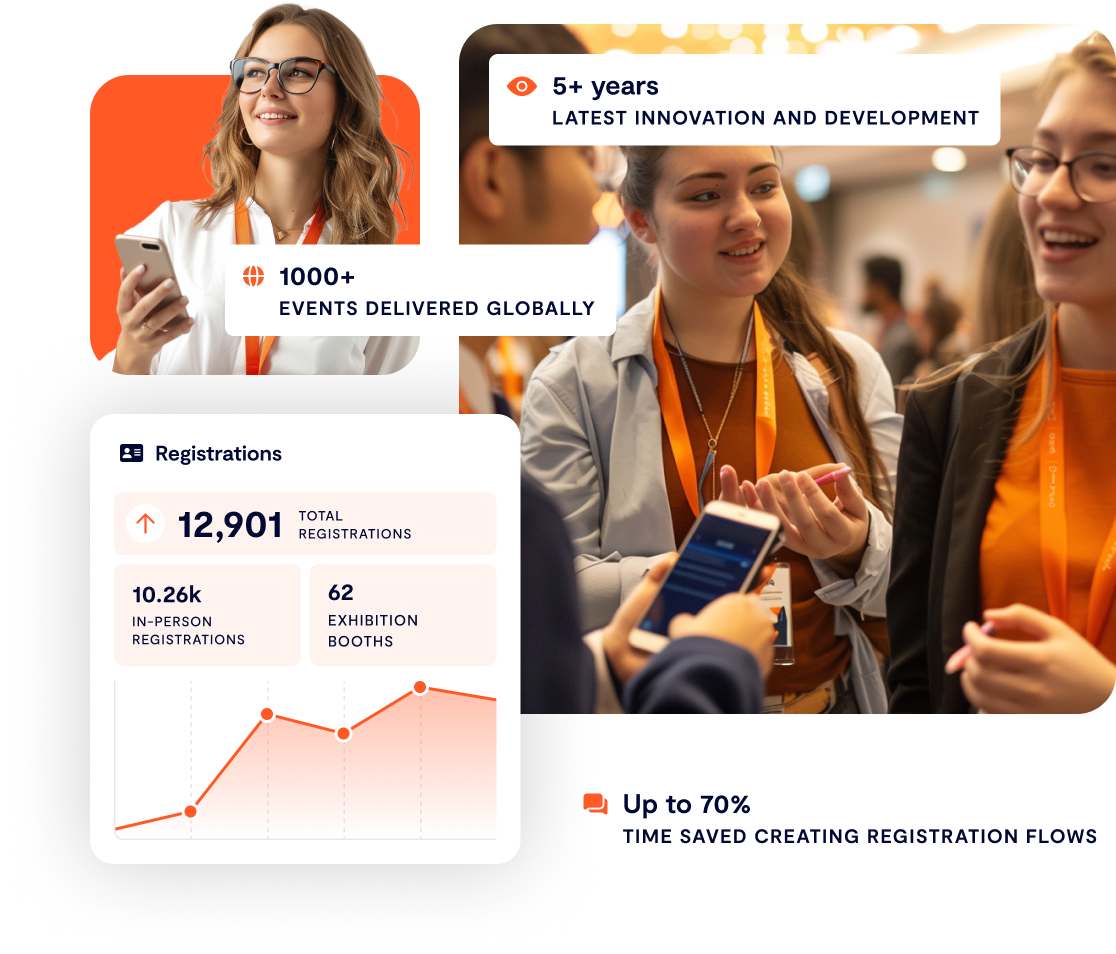
When it comes to creating your event registration form, it can be challenging to find the right balance between rigour and speed.
Go too simple, and you might miss out on important information, wasting time and money on unnecessary follow-ups.
Too complex, on the other hand, and you risk causing frustration to your potential attendees, which can make you look disorganised and could even cost you sales.
Luckily, you don’t have to leave it to chance. To help you optimise your event registration process, we’ve put together this ultimate guide to the must-have event registration features.
Responsive design
The way people access the internet has changed rapidly over the past few years, and users today expect sites and forms to respond to their unique needs.
Up to 60% of all web traffic now comes from mobile users. What’s more, almost half of people report using their mobile device to make a purchase.
In fact, users are five times more likely to abandon their cart when they’re on a site not optimised for mobile.
This means it’s critical that both your event website and event registration forms work seamlessly for users across devices, including mobile devices, tablets and PCs.
User-friendly forms
One of the most important considerations for your form is your UX, or user experience.
While UX is a complex and growing discipline, at its most basic, it relates to making intentional design decisions that help your users have a seamless, effortless and relevant experience.
This might seem obvious to some, but research shows many organisations undervalue the power of UX and digital design — a risky choice when more and more decisions are made on screens.
Thankfully, you don’t need to be an expert to make simple changes that boost your registration form experience. Some considerations include:
- Visual appeal: Does your form look appealing, polished and professional? Do your fields and questions align on the page? Is this seamless across different devices?
- Ease of use: Can users easily navigate through your form? Does it flow logically? Is it clear what actions they should take and when? Is it too long?
- Written content: Is text short, clear and to the point? Are all of your fields clearly labelled? Do your response fields (e.g. short-answer, long-form response, multiple choice) fit the questions being asked?
- Overall design: Are you gathering the right information? Is there any duplication where users have to submit the same answer more than once? Once finished, does your form tell users what to expect next?
In particular, ensuring your forms are as short as possible is a good step. Almost one in five people report abandoning a purchase because of a long or complex form.
If possible, it’s useful to invest in event management software that comes with advanced form functionality.
For example, evexus offers linear design, drag-and-drop form building and the ability to clone forms, pages and elements. This makes designing and updating your event forms less manual, saving you time, money and stress.
Personalised form experiences
Another key feature of excellent event registration forms is personalisation.
Personalised forms adapt to the user filling them out using conditional logic. By applying conditional rules to your forms, you can design different experiences for different customer groups.
For example, if an attendee indicates they’re attending a hybrid event virtually, they won’t be asked about dietary requirements, or if a registrant provides a discount code, they will instantly see the discounted ticket price rather than the standard rate.
Not only does this minimise your form length and streamline your customer’s experience, but it can also help you collect better data.
Group registrations
The functionality to register multiple attendees at once is another critical function of a well-designed event registration process.
This is especially important if you’re offering group discounts or hosting a large event where many people from the same organisation may wish to attend.
Processes that do not allow for group registrations force your customers— or your team — to spend excessive time registering each attendee. This causes frustration and can even dissuade your clientele from making larger bookings in the future.
When designing your group registration functionality, it’s a good idea to make it as seamless and pain-free as possible.
For example, evexus’ event management software includes registration features that let a coordinator purchase tickets on behalf of a group, after which individuals are invited to provide their details and opt-in to terms and conditions.
This removes unnecessary barriers for the group coordinator to overcome before booking, helping speed up the purchasing process.
Integrations and reporting
Having a great event registration process isn’t just about making life easy for attendees. A well-designed process will provide plenty of benefits to your events team, too.
Ideally, your registration forms should be integrated with your other platforms, such as your customer relationship management system (CRM), learning management system (LMS), enterprise resource planning system (ERP) and any financial tools you use.
Integrating your forms with your other programs saves you time, money and effort that would otherwise be spent manually copying information from one system to another. What’s more, by automatically syncing information between platforms, you can reduce the risk of human error.
Your events are also a rich source of data. Whether you’re looking to understand your customer base, analyse your event success or capture valuable new leads, being able to understand, analyse and report on this data is key.
This is another place where integrations can help. Alternatively, some event management software provides advanced reporting, which can be used to leverage insights and drive improvements across your organisation.
Multiple payment options
Of course, the ultimate goal for any event registration form is to get people in the door, which means taking payment in a secure, fast and user-friendly way.
Unfortunately, this is where many sites fall short. The payment stage is where most cart abandonment occurs due to a lack of perceived security, a lack of transparency around total cost and — importantly — a lack of payment methods.
Indeed, PayPal reports that 59% of consumers have abandoned a purchase when they weren’t able to pay via their preferred method.
Conventional wisdom indicates you should aim to provide at least four options. In Australia, the most commonly used online payment methods are:
- Debit or credit cards
- Digital wallets, like Google Pay or Apple Pay
- Bank transfers
- Pay later options, like Afterpay or Zip
Offering multiple secure methods of payment doesn’t just smooth the path for your attendees; it can also boost trust in your brand.
Conversion boosters
Even the best-designed websites still encounter conversion problems and cart abandonment.
This is why it pays to build in methods to keep your conversion rates high. For example, inspired by e-commerce, evexus’ innovative payment first option allows you to collect only basic data first before directing users to a payment page.
This method defers the long registration process until after payment has been made, allowing attendees to secure their place fast and preventing drop-off due to distraction or disengagement.
Of course, an abandoned purchase doesn’t necessarily mean you’ve lost the sale. Abandoned cart campaigns are a great way to remarket to those who are already at the point of purchase.
Cart abandonment emails are opened almost twice as much as regular marketing emails, and 50% of those who click through end up purchasing.
While you can follow these leads up manually, this incurs additional costs through wasted time. Instead, consider automating your cart abandonment emails through your event registration process.
This will give you all the benefits of impactful remarketing without requiring intervention from yourself or your team.
Find out more
Looking for event management software that does all of this and more? Get in touch with the evexus team to learn more or book a demo today.









